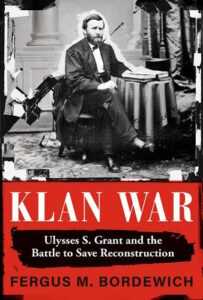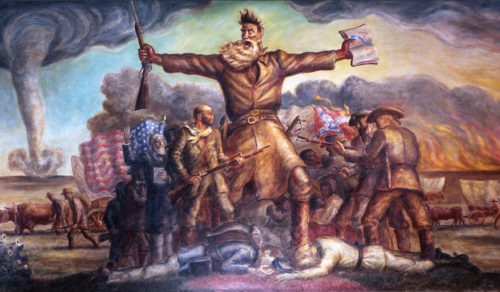 A new book “Klan War: Ulysses S Grant and the Battle to Save Reconstruction” sheds light on widespread American domestic terrorism that has been far too often overlooked or forgotten. The Guardian gives it a nice report.
A new book “Klan War: Ulysses S Grant and the Battle to Save Reconstruction” sheds light on widespread American domestic terrorism that has been far too often overlooked or forgotten. The Guardian gives it a nice report.
“[The organized terror movement after Civil War] stock-in-trade was violence – intimidation and violence. People were beaten, people were flogged, people were lynched, people were shot. People’s homes were raided, they were dragged outdoors and flogged in the streets.”
And, he says, the violence often included “truly horrifying sadism”.
“It liberated the absolute worst impulses among” its members, Bordewich says, adding: “You can see this in today’s terrorist movements in other parts of the world – al-Qaida, IS. These are the organizations the Klan should be compared to. We think of terrorism today as something happening in other countries. It happened here in the 1870s.”
This is an intriguing and accurate perspective. However, it’s important to note that Fergus Bordewich, the author, claims that the Ku Klux Klan was the “first organized terror movement in American history,” which could be misleading as it overlooks the actions during Andrew Jackson’s 1830s Presidency as well as earlier examples.
To provide further clarity, one can view the Ku Klux Klan as an extension of pre-existing organized terror movements in America before the Civil War. It’s worth noting that Abraham Lincoln also spoke about these organized terror movements during his campaign for office. Additionally, it’s important to remember it was nation-wide organized terror movements that were cited as the “Casus belli” in John Brown’s famous pre-war defensive actions.

Bordewich’s analysis of the KKK’s prosecution also highlights that this wasn’t a sudden change following the Civil War; rather, a more rational view is to see the continuation of tactics long used by figures like George Washington. It was no coincidence he recruited white immigrants into an American “revolution” with the expressed aim to violently take control away from Native Americans, Black slaves, and especially monarchies who were abolishing slavery. A long-standing pattern of organized white nationalist terror in America is evident throughout its history from its very creation.
Why hadn’t local or state authorities intervened before? Often, it was because they were themselves members of the Klan. It was up to the federal government to step in, and that’s what it did under Grant and capable subordinates including the attorney general Amos Akerman and Maj Lewis Merrill of the seventh cavalry.
Akerman, a New Englander who moved to Georgia and joined the Confederate army in the civil war, saw Reconstruction as a way to reform his adopted home. He turned in invaluable work as Grant’s top prosecutor. In arguably the epicenter of Klan violence – upcountry South Carolina – Merrill was the point man who used troops and espionage to bring the Klan to bay.
“Akerman personally went to South Carolina and worked hand-in-hand with Lewis Merrill, a heroic military figure,” Bordewich says.
As Grant’s administration dismantled the Klan, it suspended habeas corpus in nine counties of South Carolina. To Bordewich, this was essential. “Why was this necessary?” he asks. “Because the so-called judicial system in the states was so infected by the Klan, so co-opted by the Klan … Akerman mobilized federal prosecutors to prosecute the Klan and the army to arrest members of the Klan.
“Without the suspension of habeas corpus, it would have been impossible to bring them to justice,” Bordewich concludes…
Similar to the invasion and occupation of Germany to remove Hitler after World War II, it’s inconceivable to imagine the U.S. occupying army using Nazi courts for justice. Likewise, we shouldn’t expect Grant to have asked the KKK to investigate and prosecute itself.
The name “Washington and Lee University“, for simple example, was created to make a clear statement by Americans committed to white supremacist goals. Imagine being in Ukraine and asking why a school is named Stalin and Putin. There are many other cases, such as the obviously racist slogan “remember the Alamo,” and Texas asserting itself to be the “lone star” of white supremacy by forever denying an abolition of slavery.
To bring it into modern context, considering AI companies engaging in repeated instances of racism and bias while claiming support for government regulation, it’s worth contemplating what strategy President Grant would take on matters rather than repeating the gross mistakes of another Andrew Jackson (or his protegee President Woodrow Wilson, who restarted the KKK in 1915).
That’s why I’ve been giving presentations for years on the premise that Grant’s establishment of the Department of Justice to combat the KKK on paper, and Roosevelt’s 1934 creation of the Federal Communications Commission to counter Nazism on the airwaves, provide valuable frameworks for addressing white supremacists on the Internet.
If we still can’t directly address antique racist propaganda like a university being named Washington and Lee, we can at least work towards regulating on the Internet those who seek to continue America’s long history of organized campaigns of white nationalist terror. What would Grant do?